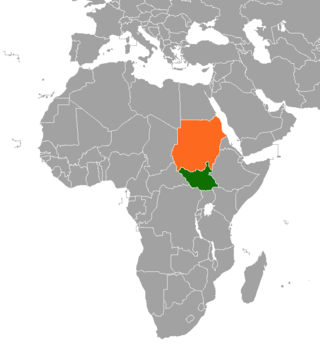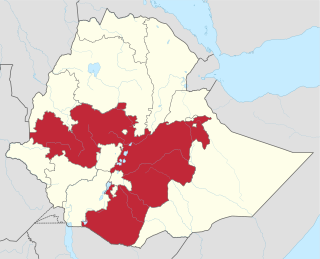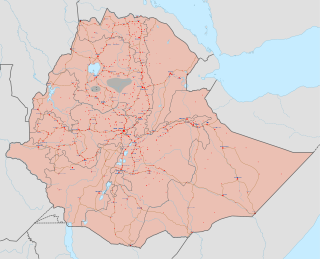Related Research Articles

Moyale is a city situated on the border between Ethiopia and Kenya. In Ethiopia, it serves as the administrative centre for two Ethiopian woredas: Moyale of the Oromia Region and Moyale of the Somali Region. In Kenya, it is the largest town in Marsabit County and the capital of Moyale sub-county.
The Kenya-Turbi City massacre was the killing of fifty-six people by feuding clans in the remote Marsabit District of Northern Kenya on the early morning of 12 July 2005. Hundreds of armed raiders of the Borana tribe attacked the Gabra people living in the Turbi area northwest of Marsabit. Twenty-two of the sixty confirmed dead were children, and over six thousand people fled their homes, most fleeing to Marsabit town. The massacre's aftermath sparked several violent inter-clan conflicts, raising the death toll to ninety-five.

The Battle of Jilib took place on the last day of 2006 during the Ethiopian invasion of Somalia. It was fought when Ethiopian National Defence Force (ENDF) troops and Transitional Federal Government (TFG) militia launched an offensive on the town of Jilib, held by the Islamic Courts Union (ICU).

The timeline of events in the War in Somalia during 2007 is set out below.

The Somali Civil War (2009–present) is the ongoing phase of the Somali Civil War which is concentrated in southern and central Somalia. It began in late January 2009 with the present conflict mainly between the forces of the Federal Government of Somalia assisted by African Union peacekeeping troops and al-Shabaab militants who pledged allegiance to al-Qaeda during 2012.

Sudanese nomadic conflicts are non-state conflicts between rival nomadic tribes taking place in the territory of Sudan and, since 2011, South Sudan. Conflict between nomadic tribes in Sudan is common, with fights breaking out over scarce resources, including grazing land, cattle and drinking water. Some of the tribes involved in these clashes have been the Messiria, Maalia, Rizeigat and Bani Hussein Arabic tribes inhabiting Darfur and West Kordofan, and the Dinka, Nuer and Murle African ethnic groups inhabiting South Sudan. Conflicts have been fueled by other major wars taking place in the same regions, in particular the Second Sudanese Civil War, the War in Darfur and the Sudanese conflict in South Kordofan and Blue Nile.
The 2010–2012 Myanmar border clashes were a series of skirmishes between the Tatmadaw on one side, and the DKBA-5 and the Karen National Liberation Army (KNLA) on the other. The clashes erupted along the border with Thailand shortly after Myanmar's general election on 7 November 2010. An estimated 10,000 refugees have fled into nearby neighbouring Thailand to escape the violent conflict. There was concern that due to discontent with the elections, and speculations of electoral fraud, that the conflict could escalate into a civil war.

This is a 2011 timeline of events in the Somali Civil War (2009–present).
Ethnic violence in South Sudan has a long history among South Sudan's varied ethnic groups. South Sudan has 64 tribes with the largest being the Dinka, who constitute about 35% of the population and predominate in government. The second largest are the Nuers. Conflict is often aggravated among nomadic groups over the issue of cattle and grazing land and is part of the wider Sudanese nomadic conflicts.

Operation Linda Nchi was the Kenya Defence Forces' invasion of southern Somalia beginning in 2011. The Kenyan government declared the operation completed in March 2012, but its forces then joined AMISOM in Somalia.

This is a 2012 timeline of events in the Somali Civil War (2009–present).
In August 2012, a series of ethnic clashes between the Orma and Pokomo peoples of Kenya's Tana River District resulted in the deaths of at least fifty-two people. The violence was the worst of its kind in Kenya since the country's 2007–08 crisis, which left 118 people dead and more than 13,500 displaced – over 50% of the 13,500 were children, women and the elderly.

The South Sudanese Civil War was a multi-sided civil war in South Sudan fought from 2013 to 2020, between forces of the government and opposition forces. The Civil War caused rampant human rights abuses, including forced displacement, ethnic massacres, and killings of journalists by various parties. Since its end South Sudan has been governed by a coalition formed by leaders of the former warring factions, Salva Kiir Mayardit and Riek Machar. The country continues to recover from the war while experiencing ongoing and systemic ethnic violence.

The Oromo conflict or Oromia conflict is a protracted conflict between the Oromo Liberation Front (OLF) and the Ethiopian government. The Oromo Liberation Front formed to fight the Ethiopian Empire to liberate the Oromo people and establish an independent state of Oromia. The conflict began in 1973, when Oromo nationalists established the OLF and its armed wing, the Oromo Liberation Army (OLA). These groups formed in response to prejudice against the Oromo people during the Haile Selassie and Derg era, when their language was banned from public administration, courts, church and schools, and the stereotype of Oromo people as a hindrance to expanding Ethiopian national identity.
The Oromo–Somali clashes flared up in December 2016 following territorial disputes between Oromia region and Somali region's Government in Ethiopia. Hundreds of people were killed and more than 1.5 million people fled their homes. The conflict ended in 2018.

The Tigray war was an armed conflict that lasted from 3 November 2020 to 3 November 2022. It was a civil war that was primarily fought in the Tigray Region of Ethiopia between forces allied to the Ethiopian federal government and Eritrea on one side, and the Tigray People's Liberation Front (TPLF) on the other.
The spillover of the Tigray war has had an impact on other countries in the surrounding region, particularly in Sudan. This spillover mainly consisted of Ethiopian refugees, more than 50,000 of which have crossed the Ethiopia–Sudan border. There have also been border clashes, mostly between the Sudanese Armed Forces and Ethiopian militias, but the Sudanese government has also claimed ambushes by the Ethiopian National Defense Force have taken place. Most of the fighting centered in Al-Fashaqa, a fertile plain claimed by both Sudan and Ethiopia.

The ongoing Ethiopian civil conflict began with the 2018 dissolution of the Ethiopian People's Revolutionary Democratic Front (ERPDF), an ethnic federalist, dominant party political coalition. After the 20-year border conflict between Ethiopia and Eritrea, a decade of internal tensions, two years of protests, and a state of emergency, Hailemariam Desalegn resigned on 15 February 2018 as prime minister and EPRDF chairman, and there were hopes of peace under his successor Abiy Ahmed. However, war broke out in the Tigray Region, with resurgent regional and ethnic factional attacks throughout Ethiopia. The civil wars caused substantial human rights violations, war crimes, and extrajudicial killings.

On 20 July 2022, the Islamist militant group al-Shabaab launched an invasion from Somalia into Ethiopia's Somali Region. Taking advantage of the instability created by the Tigray war, the goal of the operation was to establish a presence for the group within southern Ethiopia.

An ongoing refugee crisis began in Africa in mid-April 2023 after the outbreak of the Sudanese civil war. By June 2024, around 2.1 million people have fled the country, while around 12 million have been internally displaced within Sudan; these numbers include at least 75,000 migrant returnees and other third-country nationals, making the refugee and displacement crisis in Sudan the largest in African history.
References
- 1 2 3 "Ethiopia: 20,000 flee Moyale clashes - Red Cross". BBC News. 28 July 2012. Retrieved 28 July 2012.
- ↑ "Many killed in Ethiopia ethnic clashes". Al Jazeera. 28 July 2012. Retrieved 28 July 2012.
- ↑ Liban Golicha (28 July 2012). "12 killed as communities clash at border". Homex Kenya. Retrieved 28 July 2012.
- ↑ "Ambush in Ethiopia's Moyale town leaves scores dead". OPride.com. 27 July 2012. Retrieved 28 July 2012.
- ↑ "Ethiopia erupts in deadly ethnic violence". Al Jazeera. 30 July 2012. Retrieved 30 July 2012.